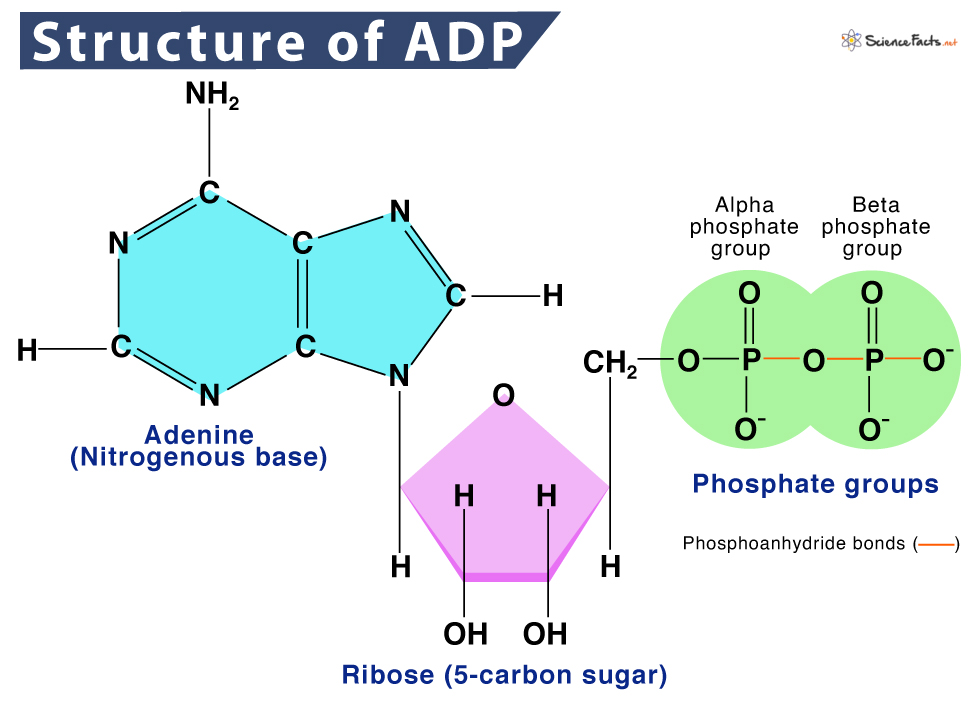Adenosine Diphosphate (ADP)
What is Adenosine Diphosphate
Adenosine diphosphate (ADP), also called adenosine pyrophosphate (APP), is an essential organic compound found in living cells. It gets interconverted into adenosine triphosphate (ATP) and adenosine monophosphate (AMP) during the energy transfer process. Thus, it has an essential role in the energy flow of cells.
Structure
ADP is composed of three components or parts:
- Adenine – a nitrogenous base (purine base)
- Ribose – a pentose sugar
- Phosphate group
This adenine and ribose sugar combine to form a nucleoside, adenosine. The adenosine gets attached to two phosphate groups. Thus, ADP as a whole is a nucleoside phosphate.
The nucleoside acts as a pentose sugar backbone with a purine base adenine attached to it at the 1′ carbon. However, the phosphate groups are bonded in series to the 5′ carbon of the pentose sugar. The two phosphate groups are labeled alpha and beta from closest to furthest from the ribose sugar. The bonds between the phosphate groups are high-energy phosphoanhydride bonds. When these bonds get broken down, they release sufficient energy to power various cellular processes.
Function: What does Adenosine Diphosphate do
1. Energy source: It helps store energy and releases it when required. During cellular activities, ADP releases water and takes in an extra energy-rich phosphate group, converting it into ATP. In this way, it aids in energy storage. When cells require energy, this ATP gets hydrolyzed and loses the third phosphate group, converting it into ADP. Thus, energy is released.
2. Blood platelet activation: When a person gets a cut, blood platelets rush towards the wound site to prevent further blood loss. Upon reaching the site, the platelets release ADP to attract and bind with other platelets, gathering them to block the cut and stop further blood loss.
ADP is stored inside the platelet and is released to interact with ADP receptors, like P2Y1 receptors and P2Y12 receptors on platelets, leading to platelet activation.
- P2Y1 receptors initiate platelet aggregation and shape change due to interactions with ADP.
- P2Y12 receptors further amplify the response, thus completing the aggregation process.
3. Cell repair: ADP plays a role in repairing damaged cells.
4. Role in protein synthesis: It also regulates the cells’ switch on and off mechanism to produce proteins. Thus, it controls the genes that get ‘turned on’ to synthesize their respective proteins.
How does Adenosine Triphosphate (ATP) become Adenosine Diphosphate (ADP)
ADP is derived chiefly from adenosine triphosphate (ATP). Whenever an ATP undergoes hydrolysis, its terminal phosphate gets hydrolyzed to release energy, and thus ATP becomes ADP. In other words, ATP gets dephosphorylated by ATPases to give ADP. The ADP, in turn, may be phosphorylated again to become ATP. This ADP can be further degraded to produce adenosine monophosphate (AMP).
When two molecules of ADP are combined during ATP synthesis by the action of the enzyme adenylate kinase, it leads to the formation of AMP.
2 ADP → ATP + AMP
In plants
In plants, this interconversion of ADP into ATP takes place through photosynthetic pathways, as light energy is stored as chemical energy in ATP.
In animals
In this case, energy can be drawn from the breakdown of foodstuff. Here, energy is accumulated via cellular respiration and stored in ATP.
-
References
Article was last reviewed on Friday, January 28, 2022




